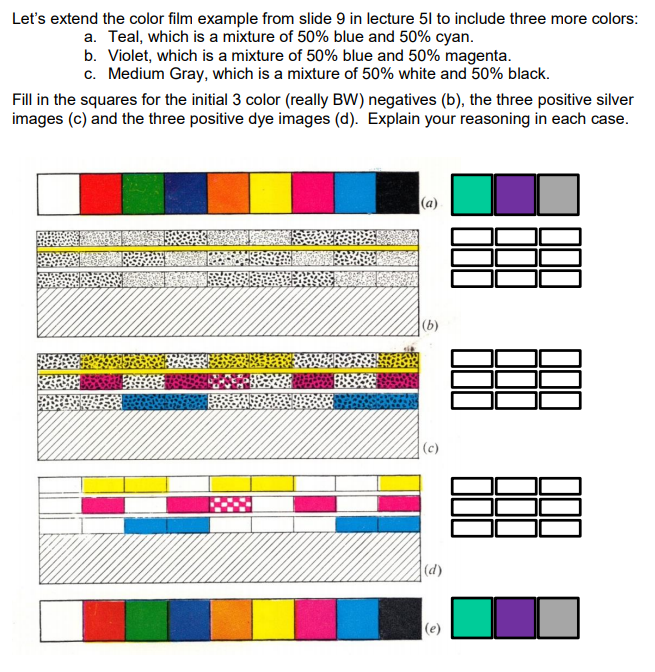Please answer the following question:
Slide 9 is right below the question.

SLIDE 9:

Let's extend the color film example from slide 9 in lecture 5l to include three more colors a. Teal, which is a mixture of 50% blue and 50% cyan b. Violet, which is a mixture of 50% blue and 50% magenta C. Medium Gray, which is a mixture of 50% white and 50% black. Fill in the squares for the initial 3 color (really BW) negatives (b), the three positive silver images (c) and the three positive dye images (d). Explain your reasoning in each case Color Photography: Subtractive Approach a) Yellow filter Substrate More complicated example: Plate III The basis of a colour reversal film e) (a) Original colour scale (b) Section of colour film. After exposure in camera and first development three negative images are formed (shown by black grains). (c) After the undeveloped emulsion is flashed or chemically fogged, colour development produces three positive silver images and at the same time three positive dye images. (d) All the silver images are bleached and dissolved by fixation leaving only the positive dye images. (e) Viewed by transmitted light, the three images reproduce the original colour Let's extend the color film example from slide 9 in lecture 5l to include three more colors a. Teal, which is a mixture of 50% blue and 50% cyan b. Violet, which is a mixture of 50% blue and 50% magenta C. Medium Gray, which is a mixture of 50% white and 50% black. Fill in the squares for the initial 3 color (really BW) negatives (b), the three positive silver images (c) and the three positive dye images (d). Explain your reasoning in each case Color Photography: Subtractive Approach a) Yellow filter Substrate More complicated example: Plate III The basis of a colour reversal film e) (a) Original colour scale (b) Section of colour film. After exposure in camera and first development three negative images are formed (shown by black grains). (c) After the undeveloped emulsion is flashed or chemically fogged, colour development produces three positive silver images and at the same time three positive dye images. (d) All the silver images are bleached and dissolved by fixation leaving only the positive dye images. (e) Viewed by transmitted light, the three images reproduce the original colour








